AMD Ryzen 7 8700G and Ryzen 5 8600G Review: Zen 4 APUs with RDNA3 Graphics
by Gavin Bonshor on January 29, 2024 9:00 AM EST- Posted in
- CPUs
- AMD
- APUs
- Phoenix
- 4nm
- Zen 4
- RDNA3
- AM5
- Ryzen 8000G
- Ryzen 7 8700G
- Ryzen 5 8600G
CPU Benchmark Performance: Rendering
Rendering tests, compared to others, are often a little more simple to digest and automate. All the tests put out some sort of score or time, usually in an obtainable way that makes it fairly easy to extract. These tests are some of the most strenuous in our list, due to the highly threaded nature of rendering and ray-tracing, and can draw a lot of power.
If a system is not properly configured to deal with the thermal requirements of the processor, the rendering benchmarks are where it would show most easily as the frequency drops over a sustained period of time. Most benchmarks, in this case, are re-run several times, and the key to this is having an appropriate idle/wait time between benchmarks to allow for temperatures to normalize from the last test.
Some of the notable rendering-focused benchmarks we've included for 2024 include the latest CineBench 2024 benchmark and an update to Blender 3.6 and V-Ray 5.0.2.
We are using DDR5-5200 memory as per the JEDEC specifications on the Ryzen 7 8700G and Ryzen 5 8600G, as well as DDR4-3200 on the Ryzen 7 5700G and Ryzen 5 5600G. The same methodology is also used for the AMD Ryzen 7000 series and Intel's 14th, 13th, and 12th Gen processors. Below are the settings we have used for each platform:
- DDR5-5200 CL44 - Ryzen 8000G
- DDR4-3200 CL22 - Ryzen 5000G
- DDR5-5600B CL46 - Intel 14th & 13th Gen
- DDR5-5200 CL44 - Ryzen 7000
- DDR5-4800 (B) CL40 - Intel 12th Gen
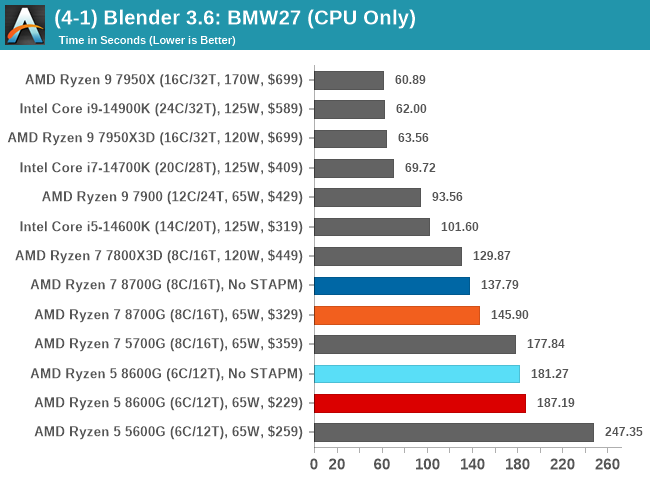
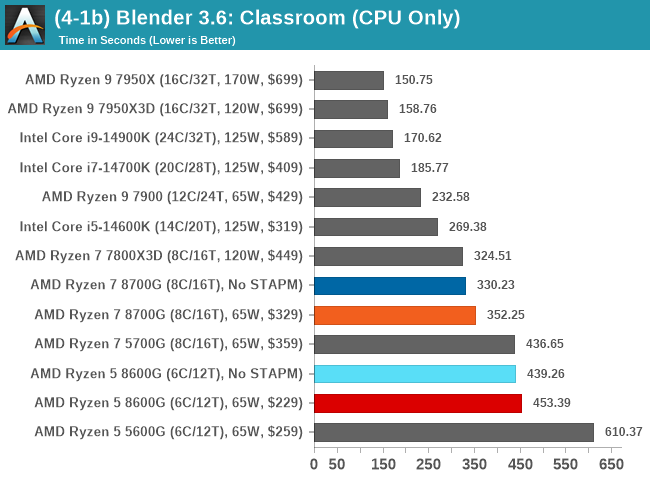
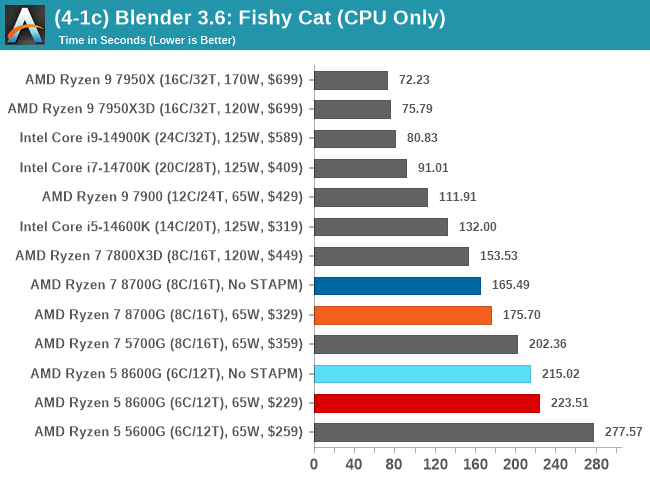
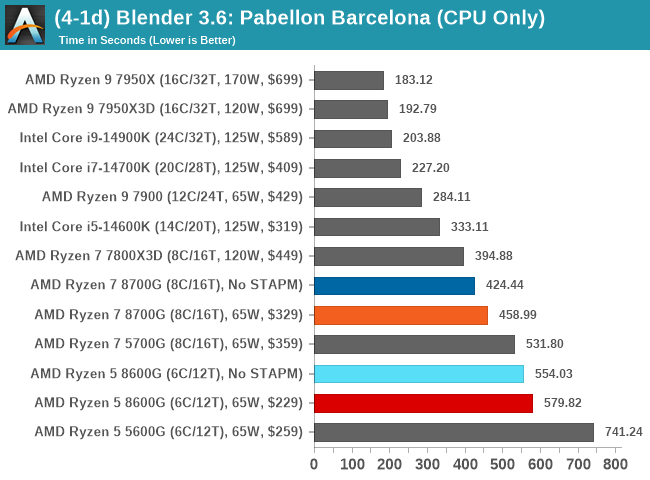

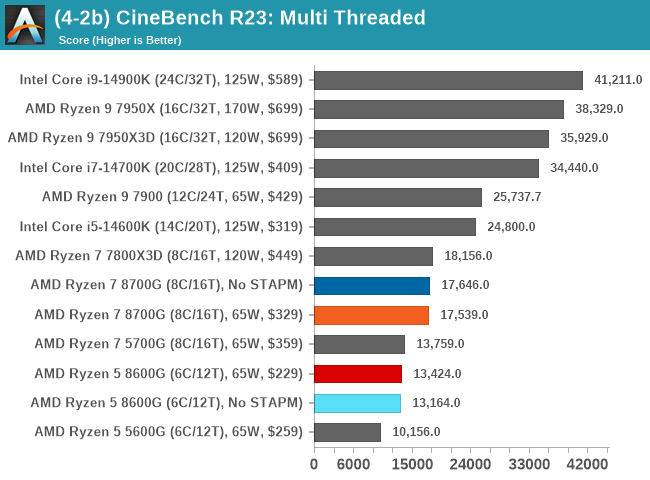
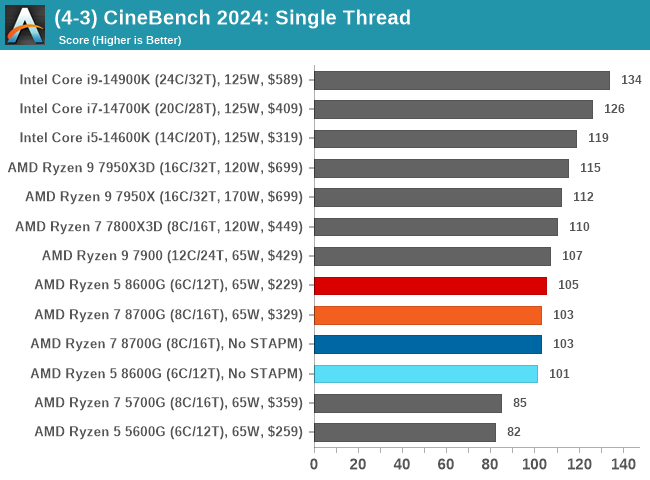
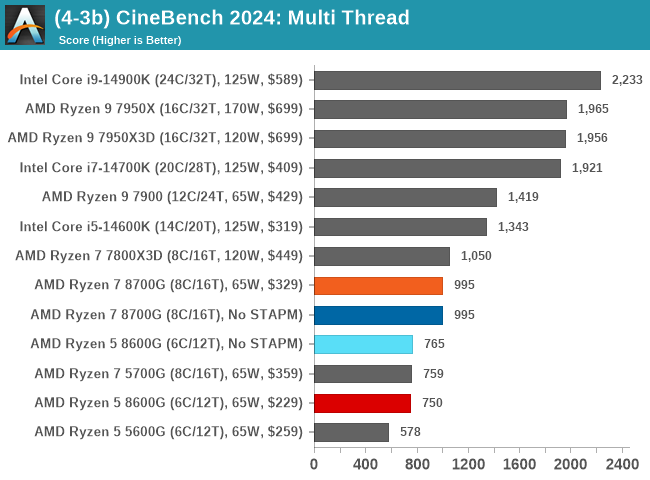

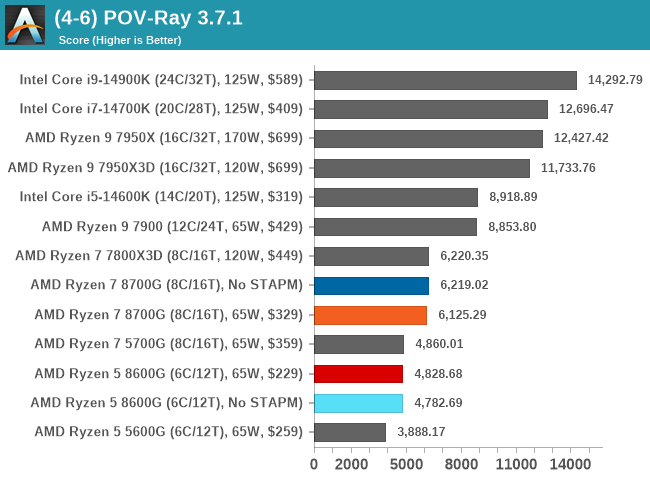
Another area where a mobile-based chip ported to a desktop doesn't quite match the bigger desktop chips is in rendering, a quintessential power and multi-threaded scenario where more cores and threads typically equate to higher performance. Both the Ryzen 7 8700G and Ryzen 5 8600G beat out the Ryzen 5000G series APUs, although the Ryzen 7 5700G consistently beats the Ryzen 5 8600G as we would expect from having two more cores with four more threads.
In our rendering tests without STAPM limitations, we saw notable gains in performance in Blender 3.6. The performance increase without sustained power loads being limited, we're seeing up to 7.5% better performance across the longer tests, with around 5% more performance in the shorter tests.










111 Comments
View All Comments
nandnandnand - Tuesday, January 30, 2024 - link
I could have sworn that was in here, but I was probably thinking of other reviews.Short story long, AnandTech is dying and you should go to other sites for reviews now. And the 780M iGPU in the 8700G is not going to do well against a 2060/3060. It seems to be around a GTX 1650 in performance.
is4u2p - Wednesday, January 31, 2024 - link
Uh, the M1 had dedicated NPUs in it and it is a desktop processor.As for these, they're Z1 and Z1 Extreme APUs rebranded, you can get these in the handheld gaming machines.
Stu7nm3dflash - Thursday, February 1, 2024 - link
Certainly Apple has a lot of machine learning built in, this iPad Mini 6, has 16 tflops of ML, more than the M1, but little access to big amounts, of short term memory, my Ryzen 5 8600, only has 16 tflops, but I've given it 64GB of DDR 5 and PCIe4. Fingers crossed, for my creative work. ARM, is more power efficient, the M1,2,3, Pro, Max, Ultra, iPhone, Apple TV, iPads all have ML, plus unified memory and PCIE4. But amount of memory is also important, 64GB of DDR 5 only cost me $A200, PCIE4 $ 100, motherboard $125, chip $A375, my Mac mini M1, only has 8GB, of unified memory, it crashed immediately, under AI model load.Stu7nm3dflash - Thursday, February 1, 2024 - link
My use case, is a bit different, turning 2 stories, 11 pages into 80 pages, at first, online, I got 3 paragraphs. Then on an 8 core, 4000 series, Ryzen 7, with 32 GB of DDR 4, PCIe3, I got 4 pages, now, 64GB of DDR 5, PCIe4, Ryzen 5 8600, with 16 tflops of AI, I'm hoping for more pages, before it crashes. At double the short term memory, at double the speed, double speed long term memory, a specific AI architecture and 4nm nearly 3 times the transistor density, of 7nm, last time I used Jan.ai, plus a model, easiest build yet. Fingers crossed, more specific processing, 4 times the short term memory power, I hope I'm getting closer, memory, processing and software continue to advance.GeoffreyA - Thursday, February 1, 2024 - link
Perhaps you'd get better results with a GPU upgrade?peevee - Thursday, February 1, 2024 - link
Too bad 8700G is hamstrung by only 65W and PCIe4 (and only 2 RAM channels).Maybe their graphics department insisted on these things to preserve sales? APUs would be so nice at 4 DDR5 channels and 200W...
meacupla - Friday, February 2, 2024 - link
Socket AM5, with its 1718 pins, doesn't have enough pins for quad channel DDR5.While I don't think it would require 4844 pins like sTR5 for threadripper, it would require a new socket.
vertigoz - Saturday, February 3, 2024 - link
I would love to see benchmarks of ai/3d using GPU, allowing much more ram can be a major plusblackie333 - Wednesday, February 7, 2024 - link
I really care more for IDLE power consumption than maximum power because I use my PC mostly for reading/music listening. Gaming or crunching videos is not my daily routine.These integrated AMD CPUs have been chosen by many because of their much better IDLE power efficiency compared to normal desktop models.
I haven't found idle power consumption comparison with older gen. models in the article.
I'm getting old and my eyes don't serve me as good as before, maybe it's there somewhere but can't find it.
masb - Friday, February 9, 2024 - link
Excellent comparison, especially regarding the OpenFOAM topic. Where can I access the complete specifications for the Intel Core i5-14600K system?